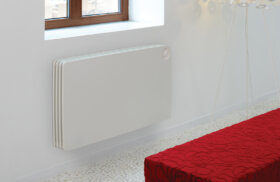The radiator is one of the greatest inventions of modern times. Can you imagine how miserable and cold life would be without central heating? Not to mention the smog we’d be coughing in caused by the increasing population burning more and more coal and wood on their fires (if there was any coal left that is!).
So who do we have to thank for being able to live and work in shirtsleeves even in the depths of winter? The internet is littered with engineers who were said to be the inventor of the radiator. One claimant, as we’ve already said in an earlier piece on the best radiators for Victorian and Edwardian houses, was the Frenchman Jean Simon Bonnemain. At the end of the 18th century, he produced a hot water system intended to incubate chickens – it just so happened that it was also an ideal way of heating homes.
Fast-forward to 1831 when Angier Marsh Perkins was granted a UK patent for the Perkins Steam Heater, a closed hot water system that he developed for domestic use. The American Joseph Nason worked with Perkins for a while before moving back to the US to establish his own company which went on to become the American Radiator Company. Nason patented a primitive type of radiator in 1841.
Then along came the Prussian inventor Franz San Galli who patented the ‘hot box’ in 1857, which was the closest to what we now call a radiator. The success of his invention took off after he was asked to renovate the heating system in the imperial greenhouses in St Petersburg.
Style and substance
The main conclusion is, therefore, that we can’t attribute the invention of the modern radiator to any one person, rather it was an evolution of different ideas from around the world that culminated in the radiator that we know and love today.
Indeed, the basic product has been going strong for well over 150 years, with the cast iron radiator never going out of fashion. And since the Heatwave was designed in 2003, the radiator has also become a functional work of art in its own right.





